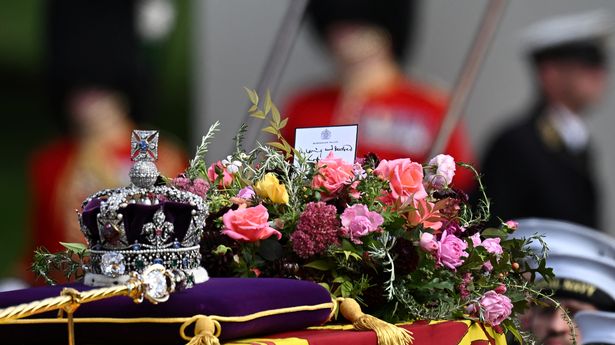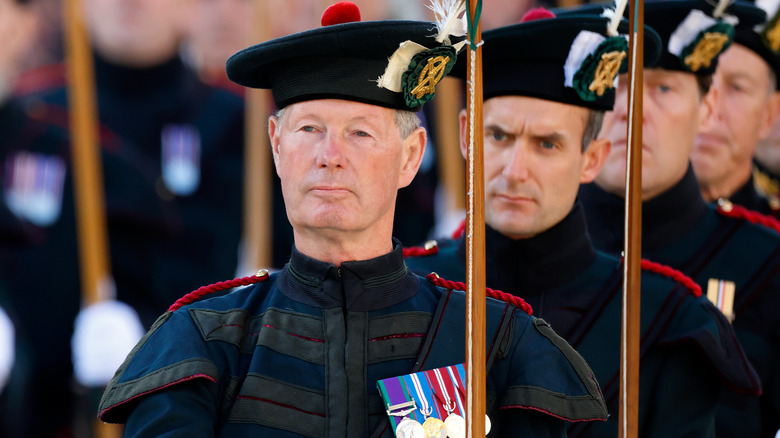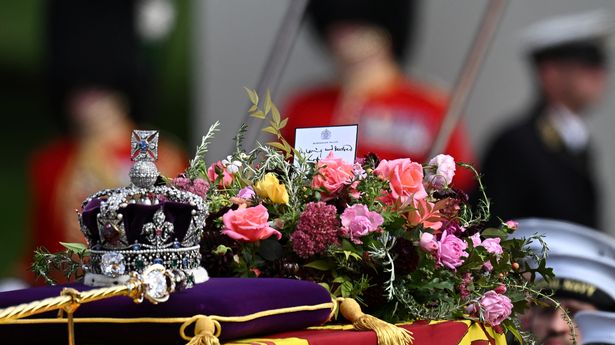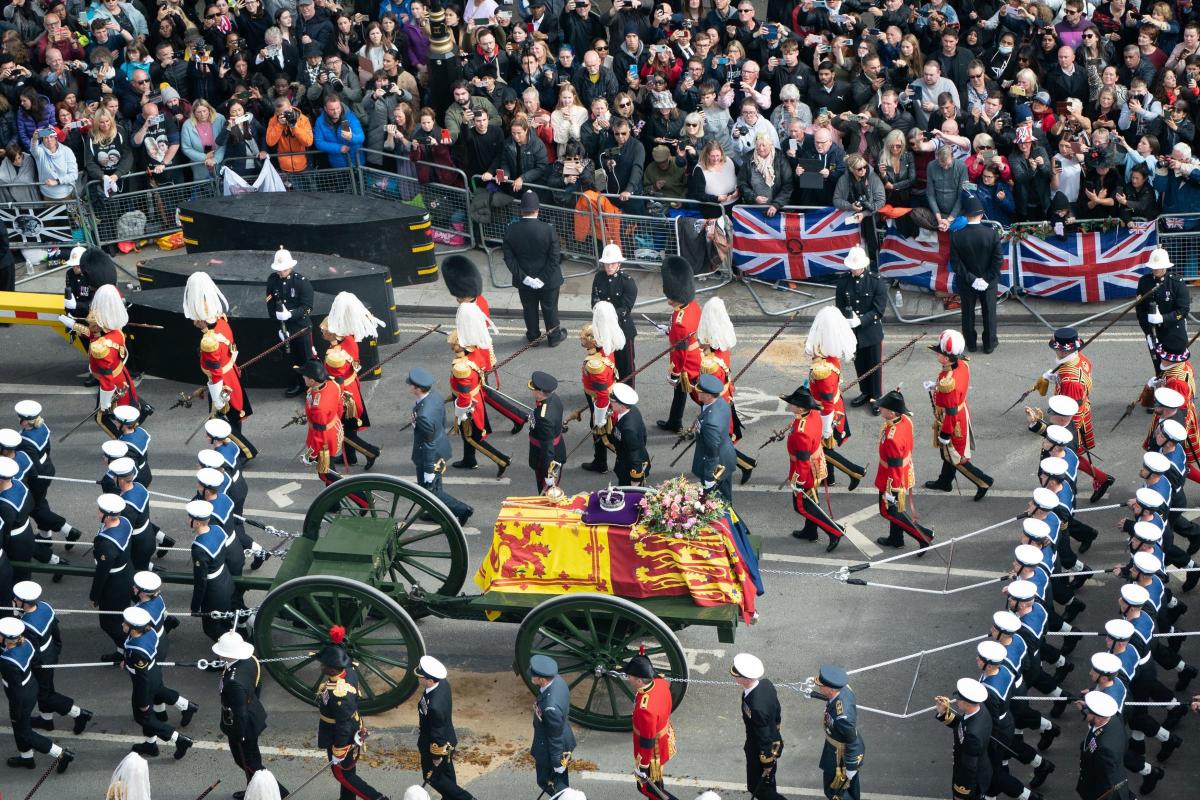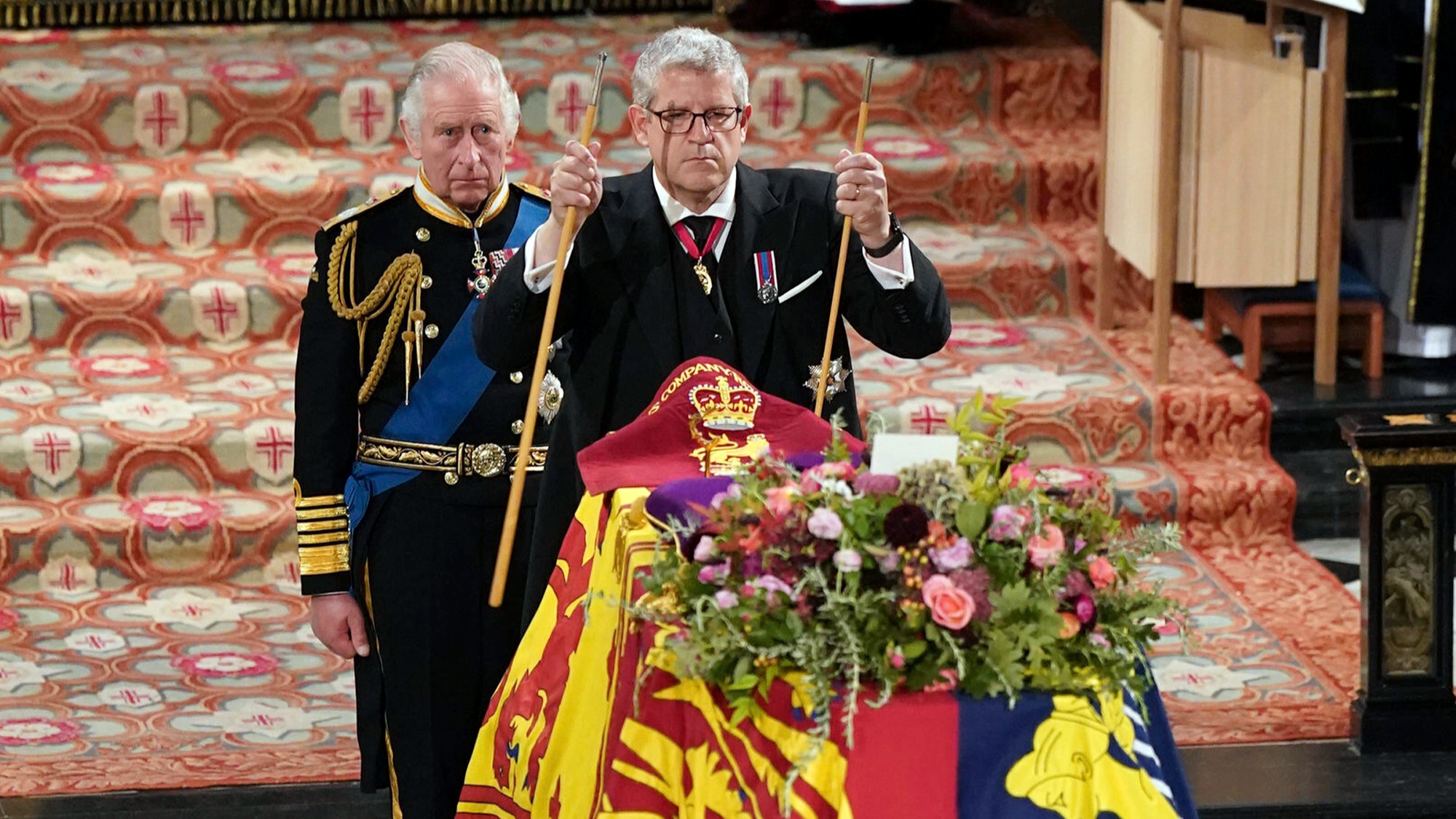For the weeks following the death of Queen Elizabeth II, Britain was on show. There followed two weeks of ceremony, tradition, and queuing which drew the attention of the world. Ceremony is what the monarchy does best. Its entire existence is predicated on traditions and splendour that date back centuries specifically with the goal of visually impressing the masses thus inspiring loyalty from the serfs peasants subjects.
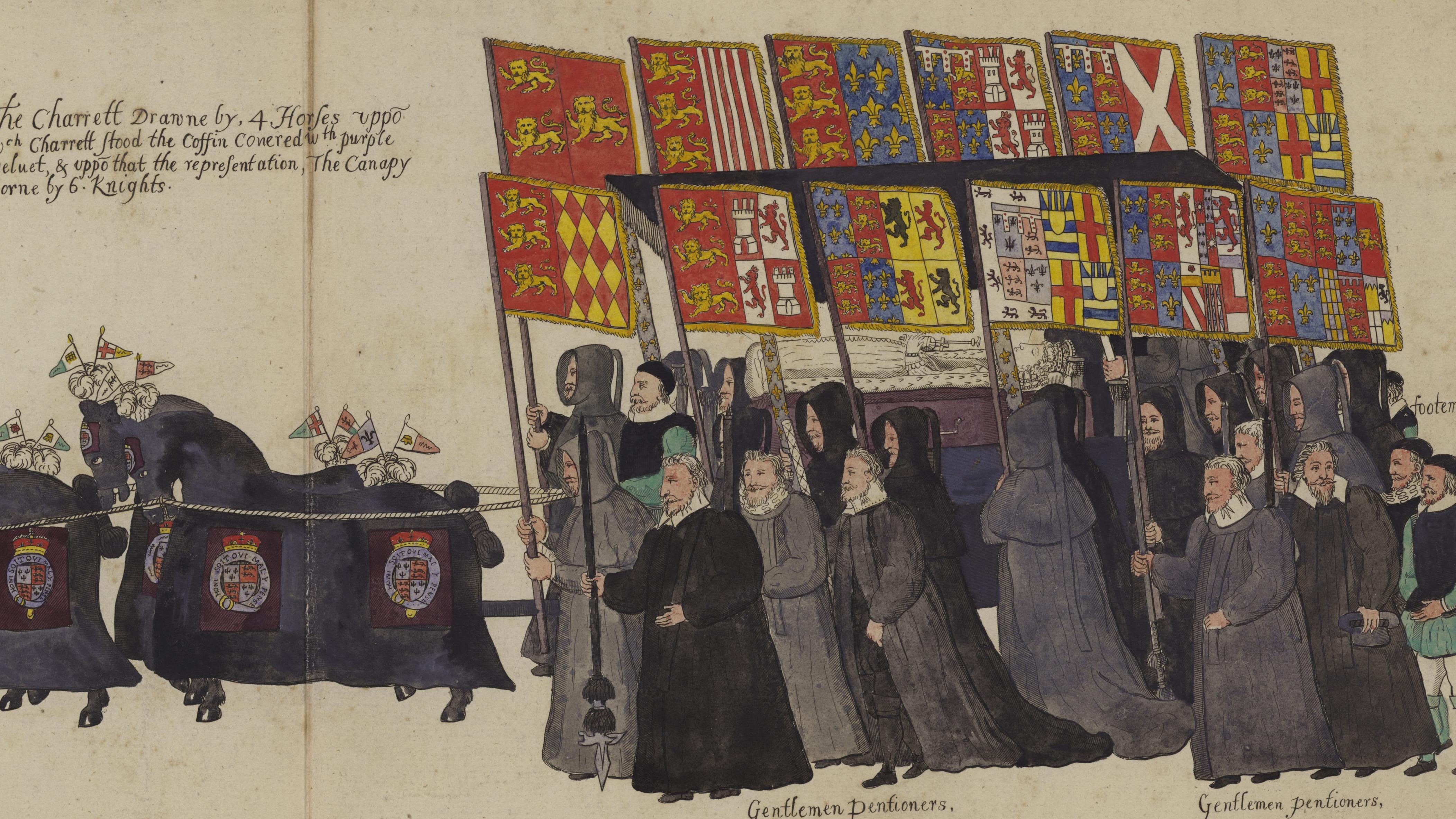
While visually impressive, many of the elements have little meaning beyond the fact that they’re traditions. In the modern day, most of these conventions exist for the sake of existing. They hearken back to earlier spectacles, invoking a sense of royalty that endears them to the people but have little practical application. Some of the details are sentimental, displaying the royal family as a family of people who recently lost their matriarch as well as the monarchy who have lost their figurehead. We’re going to look at some of these visual elements and traditions, looking at where they came from and their significance today.
The Uniforms
The House of Windsor has a long association with the military. With the exception of William IV, Queen Victoria’s predecessor, few monarchs had any military connections beyond the honorary roles that come with the crown. The House of the Windsor however, has strong associations with the military, mostly because they have a tradition of skipping the heir to the spare that was never meant to be king.
George V was a career naval officer until the death of his older brother meant that he was going to be King. His second son didn’t expect to be king and also joined the Navy but would go on to become George VI. His daughter, who would be Elizabeth II, married the naval officer Philip Mountbatten who had renounced his titles as Prince of Denmark and Greece in order to marry her.
Their children Charles and Andrew would briefly enter the armed forces before becoming full-time working royals, as did Charles’ children, William and Harry. Though convention sees them wearing military uniform at events their uniform of choice is ceremonial and doesn’t relate to their military service.
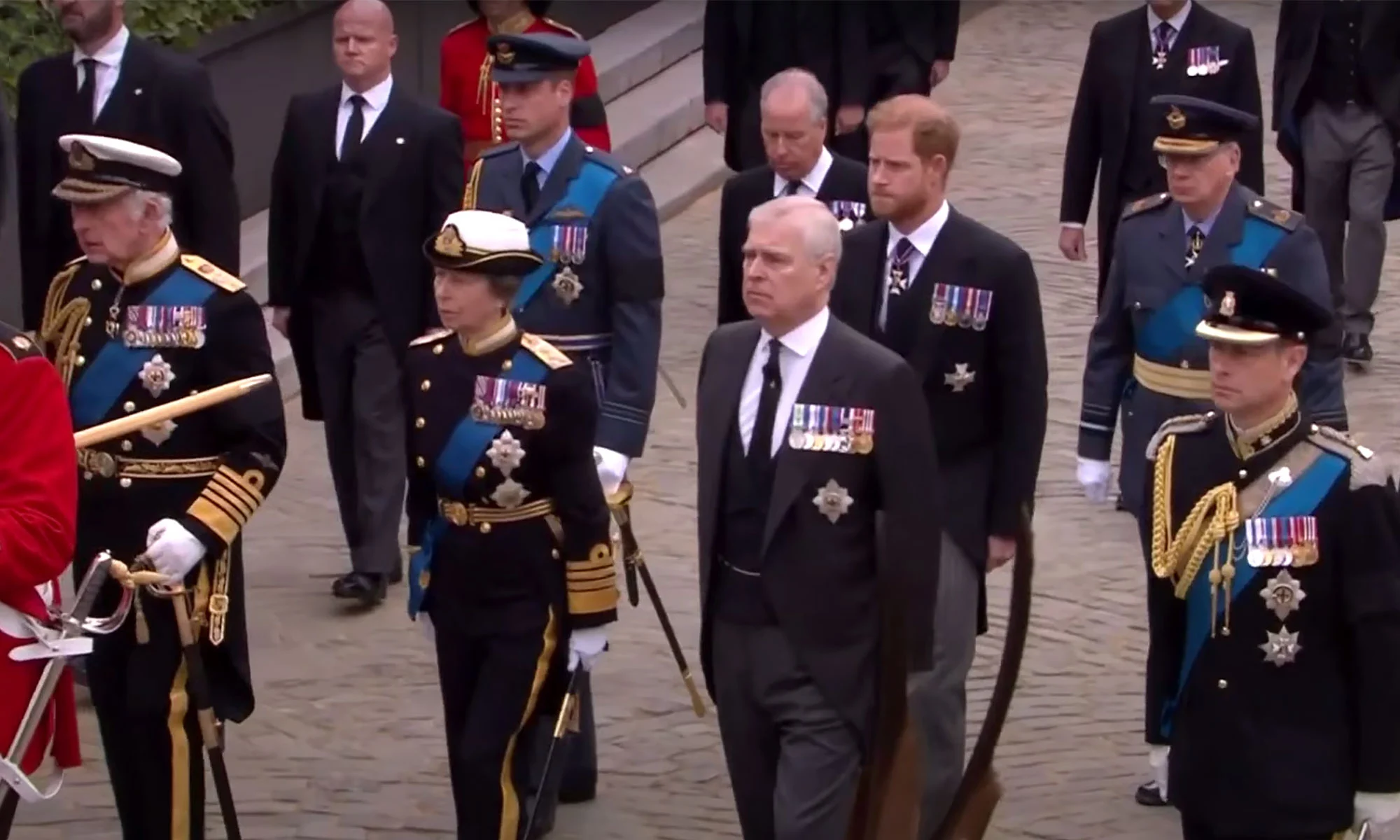
The King wore the naval ceremonial dress of an Admiral of Flag rank despite never being promoted above Commander during his service in the Navy. He wore it with several embellishments and honours including;
- The Collar of the Order of the Garter
The Order of the Garter was established by Edward III in 1348 to recognise national contribution, public service, or personal service to the sovereign. As Prince of Wales and now sovereign himself, Charles has automatic membership. - The Sash of the Order of the Thistle
The Order of the Thistle is the Scottish equivalent of the Order of the Garter, revived by James VII of Scotland to recognise the contribution of Scottish men and women to national life. Charles was created an Extra Knight of the order in 1977. - The Order of Merit neck order
The Order of Merit recognises distinguished services and admission is the sole gift of the sovereign. Charles received admission in June 2002. - The Garter Star
The Garter Star is another decoration that comes with the Order of Merit - The Thistle Star
This is just another decoration for the Order of the Thistle. He effectively wore four accessories to display two honours.
The King also wore several medals which were mostly issued as commemorations of past jubilees.
His son, William now Prince of Wales and a Flight Lieutenant in the Royal Air Force wore the ceremonial dress of an RAF officer. He wore the Order of the Garter Sash and chest order with RAF pilot wings that show he’s a qualified pilot. His medals commemorate his grandmother’s gold, diamond, and platinum jubilee.
Prince Edward, Earl of Wessex, and Princess Anne didn’t serve in the armed forces (though Edward spent some time as an officer cadet of the Royal Marines) but they both wore ceremonial uniform. Prince Edward wore the uniform of the Blues and Royals, the second most senior regiment in the armed forces. He wore the Order of the Garter star and sash, and the Grand Cross of the Victorian Order, a reward for personal services to the monarch. His sister, Princess Anne, in the uniform of an Admiral of the Royal Navy, wore the Thistle sash, star, the Order of the Garter, and the Royal Victorian Order of which she is the Grand Master.
There were over four thousand military personnel representing a large number of the different regiments of the armed forces at the funeral procession. We’re just going to cover a few of the more iconic uniforms on display. The three most identifiable make up the Sovereign’s Body Guard which is an entirely ceremonial role and serves no modern military function, though their members may have engaged in military service. They shouldn’t be confused with the King’s Guard (or the Queen’s Guard as it was until recently) which protects the official residences of the royal family but also have ceremonial duties. They’re the ones with the distinctive tall bearskin hats.
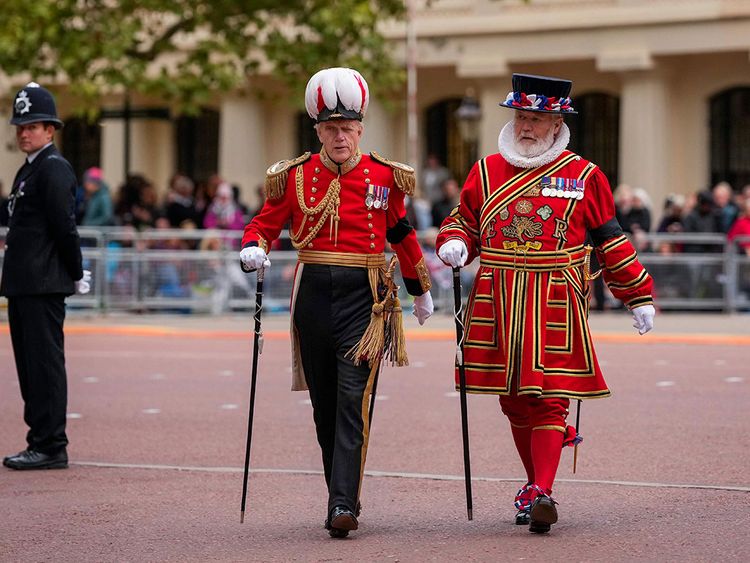
The Yeomen of the Guard
The full title of the regiment is The King’s Body Guard of the Yeomen of the Guard but are colloquially known as ‘beefeaters’. It’s the oldest military corps in Britain founded by Henry VII in the wake of the Battle of Bosworth Field. They were responsible for the sovereign’s protection by lining the corridors and hallways of the royal residences. Their numbers and responsibilities were diminished after the English Civil War and subsequent execution of Charles I. From the mid-1800s they took on a ceremonial role which they fulfil in the present day. Their uniforms are almost identical to those of the Yeomen Warders who guard the Tower of London which leads to them being frequently confused as the same unit. (Their uniforms have a slight difference in that the Yeomen of the Guard wear cross belts from their left shoulder).
Gentlemen at Arms
His Majesty’s Body Guard of the Honourable Corps of Gentlemen at Arms stood out at the procession with their incredible headdresses. They were founded in 1509 by Henry VIII who required a mounted escort to protect the sovereign in battle (or elsewhere). They were armed with spears and lances and offered employment to the younger sons of noble families who would not have inherited their family title. They were a military unit for only a hundred and fifty years, when they became ceremonial after the execution of Charles I, presumably because they only had one job and Charles’ head ended up on a stake.
The Royal Company of Archers
Another unit with a very long name; The Royal Company of Archers, the King’s Body Guard for Scotland have been around since the late 1600s in the form of a private archery club. They compete in several private annual events but since 1822 have also acted as the royal bodyguard in Scotland, which means they don their uniforms and attend the sovereign when they approach within five miles of Edinburgh. It was members of this company that carried the queen’s coffin when she lay in state in Scotland.
The Wreath
The wreath of flowers placed upon the coffin was designed with the input of the new King. The flowers included roses, hydrangea, sedum, dahlias, and scabious of gold, pink, and burgundy, with white accents to compliment the Royal Standard.
Within the wreath was a memorial to the queen’s late husband, Prince Philip, including rosemary for remembrance, oak for love, and myrtle. Myrtle is an ancient symbol of a happy marriage and the sprigs used in the wreath were cut from a plant grown from a cutting from the queen’s own wedding bouquet in 1947.
The flowers were taken from Buckingham Palace and the king’s gardens at Clarence House and Highgrove House. The wreath was sustainably made and created without floral foam, presented in a nest of moss and oak branches. It will be buried with the queen and her husband at Windsor.
The Heralds, the Kings of Arms, and the Royal Household
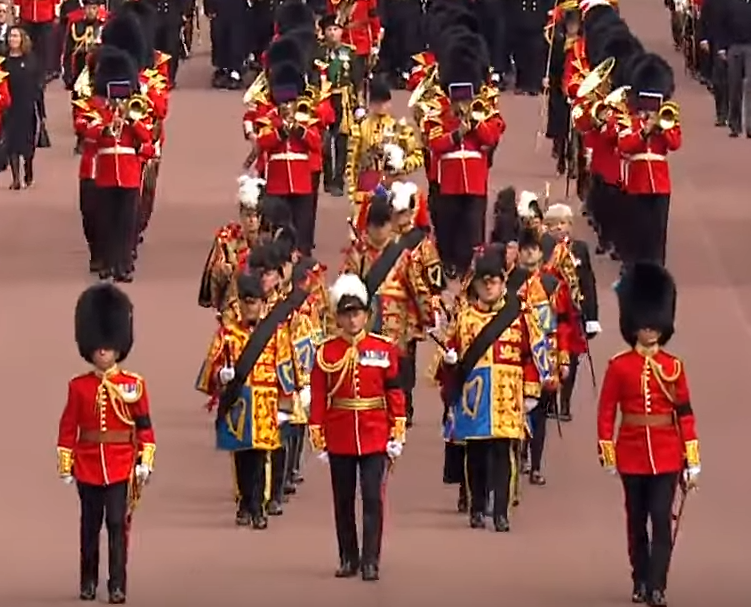
During the funeral procession, the block directly ahead of the gun carriage carrying the queen’s coffin was made up of the heralds, Kings of Arms, the Royal Household, and several senior officers and combined bands from the divisions of the household guard. The household guard consists of the most senior and historically significant regiments in the United Kingdom; the Life Guards, the Blues and Royals, the Grenadier Guards, the Coldstream Guards, the Scots Guards, the Irish Guards, and the Welsh Guards. They made up the bulk of the military presence that appeared in the procession.
The senior officers walked at the front of this contingent. Behind them came the Kings of Arms and the heralds. They are officers of the College of Arms which was founded in 1484. The college is the authority on arms, heraldry, and pedigree, assisting the government and the palace with all heraldic matters. They answer to the Earl Marshal, the Duke of Norfolk who is responsible for the organisation of state functions, including the funeral in which they were marching.
The two senior of the three kings; The Garter King of Arms and the Clarenceux King of Arms were responsible for the proclamations that announced King Charles III as king. Behind them, walking among the bands of the Scots Guards and the Coldstream Guards, was the Earl Marshal himself. The position was created in 1386 and has mostly been held by the Dukes of Norfolk, as it is today. It is this position that elevates the Duke to the premier peer of the realm. Now that the funeral is over, the Duke will be turning his attention to the coronation of Charles III.
Forming the rear of this group, directly ahead of the gun carriage came members of the royal household. These include historical roles such as Keeper of the Privy Purse, Master of the Horse, and Treasurer of the Household which stretch back to the 1500s and beyond, to more recent roles such as the Sovereign’s Private Secretary established in the nineteenth century, or the Director of the Royal Collection created as recently as 1987. Among them were some of the more obscure members of the royal household; two of the Queen’s Gurkha Orderly officers who represent the British Indian Army, and two of the Royal Watermen who are responsible for rowing the royal barge up and down the Thames (something that has been obsolete for centuries).
The Gun Carriage
The use of a gun carriage is a relatively recent addition to state funerals compared to some of the traditions that date back to Edward the Confessor’s death in the eleventh century. Queen Victoria requested the use of one after seeing her son, Prince Leopold, conveyed on one for his funeral after his sudden death in 1884. The carriage was manufactured in 1896 and converted for use in funerals in 1899, ready to be used for the first time in 1901 for Queen Victoria’s funeral.
Initially, it was intended to be pulled by horses, however there was some confusion when the event came and the horses were deemed unsuitable. Instead, her grandson asked the commander of the Royal Navy if the sailors could pull the carriage using improvised drag ropes. The same carriage was used in the state funerals that followed it, including that of Queen Elizabeth II, and has been pulled by sailors according to the tradition set down by Queen Victoria’s funeral.
Sticks, Rods, and Breaking Staffs
Among the ceremonial roles we were introduced to during the procession were some obscure sounding positions, namely the Black Rod, the Gold Stick, the Silver Stick, and with it comes several related positions such as the Gold Stick in Waiting and the Silver Stick Adjutant.
The Black Rod is one of the senior officer of the House of Lords. The position is appointed by the Crown and is referred to as the Lady or Gentleman Usher of the Black Rod. Their entire role, created in 1350, includes carrying (wait for it) a black rod which they carry as they lead people around the House of Lords, taking them where they need to go. As the queen lay in state, it was the Black Rod that closed The Queue of people passing by her in Westminster Hall.
The four positions involving sticks began life as bodyguards. The office of the Gold Stick originates in the sixteenth century. There are two of them who were appointed as bodyguards to the sovereign named for their staff of office which had a gold head. While on duty, one acts as the Gold Stick and the other is the Gold Stick-in-Waiting and their duty was to protect the sovereign from the moment they rose from bed to the time they returned to it. Since the 1900s their roles have been entirely ceremonial. The Gold Stick-in-Waiting has a deputy in the Silver Stick, and the Silver Stick has an aide called the Silver Stick Adjutant. The Silver Sticks were created in the late 1600s and given the charge of all the ceremonial duties for the sovereign. Scotland has their own Gold Stick, Silver Stick, and related deputies from the senior officers of the Royal Company of Archers.
The final act of ceremony occurred at the committal of the queen’s coffin at Windsor where she was later laid to rest. The Lord Chamberlain, the most senior officer within the Royal Household, is responsible for overseeing all the departments within the household. They also organise all the ceremonies attended by the royal family among several other duties. The role was created in 1399 and their final duty, historically, has been to break their wand of office over the sovereign’s coffin at their funeral. This signifies the end of their duties.
The wand of office broken over Queen Elizabeth’s coffin was clearly designed to be collapsible and broken in the centre but this wasn’t always the case. In the past, they used a staff of office which was smashed over the coffin, and the ceremony wasn’t limited to that of the sovereign. When Arthur Tudor, Prince of Wales died in 1502, the Lord Chamberlain of his household as Prince of Wales did the same, signifying the end of an era. It’s appropriate that it was the final element of the funeral, as for all the pageantry and tradition, it was most certainly that.
If you’d like to join me for more fun and games in picking apart history, and other behind the scene tangents, you can support me via my Patreon.

